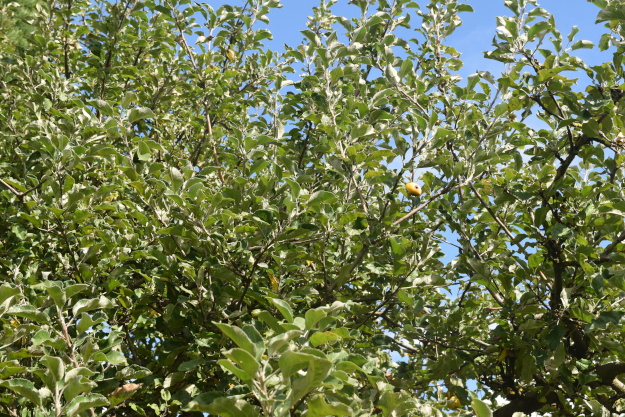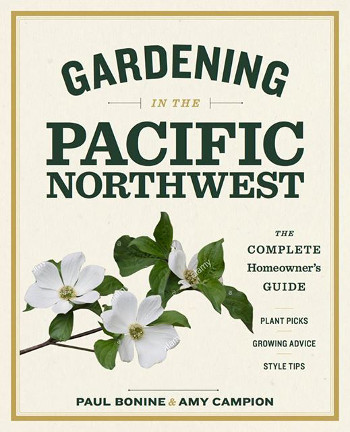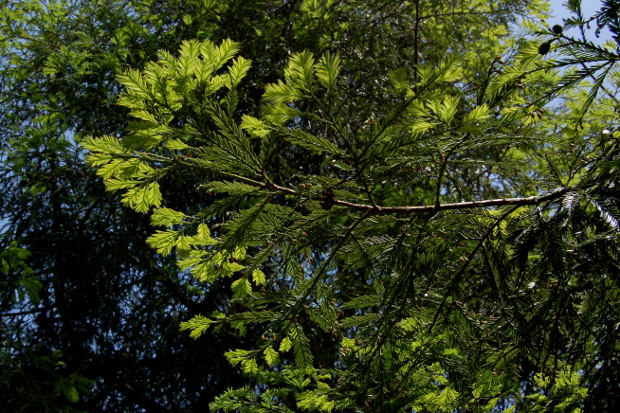
It’s mid-May, and I’m working in my garden when I hear voices coming from the direction of my neighbor’s apple tree. Peeking over the fence, I see two men with saws and pole pruners. I feel a flutter of apprehension. I’ve seen the carnage that untrained tree trimmers can inflict on a tree, and the lack of safety equipment tells me that these gentlemen are not Certified Arborists.
Certainly, the old tree could use some pruning. From the looks of it, it has never been pruned. I’m guessing it’s been growing there as a free spirit for 60 years or more; it was probably planted shortly after the little ranch house was built in 1956. Now, its five sturdy trunks, each spanning 10 inches across, form a vase-shaped canopy that fills nearly half the backyard. Smaller branches, clothed in fresh green foliage, sprout from the main trunks in profusion. Each fall, the apple crop is abundant, though the fruits are rather sour. The tree is healthy and productive.
I go back to working in my garden and try to tune out the sound of falling branches. I’m renovating my garden this year, replacing most of my purely ornamental plants with more wildlife-friendly options. I’ve been reading about gardening for wildlife, and it’s got me eager to make some changes. I’m encouraged by the diversity of insects I’m already starting to see. I’m learning about the bees and bugs and wasps and dragonflies that dwell in my garden, and I’m loving it.
I glance at the apple tree. The men have removed some of the lower branches and there’s a glimmer of light under the tree. The shade is less oppressive there now. I’m hopeful. I go inside and take a break.
I try not to keep checking out the window, but I can’t help myself. It’s not good. The men are working slowly but steadily, and more and more branches are coming down. Should I say something? What can I do? The men are just doing their job, and the landlord is nowhere to be found. I haven’t seen her since she bought the place four years ago.
When I go back outside, it hits me. These men are not pruning the tree. They’re cutting it down. These are not pruning cuts. These are the kind of cuts you make to a tree that’s being removed. Large limbs, cut straight across, leaving gaping wounds. The tree’s shape utterly destroyed. Masses of foliage removed, with little left for photosynthesis.
In the seven years I’ve lived next to this old tree, I’ve never given it much thought. Now, I’m crestfallen. I can see how it’s blocked the view to other backyards, and I realize how it has sheltered my garden from the blustery east winds that rip through our neighborhood. More importantly, I think of the countless native bees and other pollinators nourished by its flowers each spring and of the many caterpillar species that feed on its foliage (155 of them in the Portland area, according to the National Wildlife Foundation website). I think of the songbirds, in turn, who rely on those caterpillars to feed their chicks and who nest and perch in its branches. All that habitat will be gone.
It’s getting late. It will be dark soon. The men are still working. What’s taking so long? Let’s just get it over with.
They’re packing up! They’re not taking the tree down after all. They’ve topped it, and now they’re leaving. I don’t know which is worse—topping a tree and ruining its shape for the rest of its life, or taking it out altogether despite it being perfectly healthy. All I know is, I have a knot in my stomach.
I’ve recently read A New Garden Ethic: Cultivating Defiant Compassion for an Uncertain Future by Benjamin Vogt. It’s a thoughtful, inspiring book about gardening in an era of global warming and mass extinctions. One passage in particular keeps coming back to me: “Be willing to love with a broken heart,” he says, “to foster that breaking and touch the world that so many hold at a distance to protect their identity.” Faced with sad stories about habitat destruction on a daily basis, many of us turn away in despair. We must remain engaged, Vogt says, and keep fighting for nature, even though at times it breaks our heart to acknowledge what we’ve done to it.
“I don’t want to always feel better in my garden,” Vogt writes in A New Garden Ethic. “I don’t want to be healed. I need my pain. I need my anger. These emotions are not enemies but indicators of empathy and compassion. They let me know the depth of my feeling and the power of all life struggling for justice and equality.”
In the days and weeks that follow, when I glimpse that tortured tree, I respond with anger and sadness, but also love. Not giving in to despair, I do what I can to give wildlife a fighting chance. I plant more natives in my garden—willow, chokecherry, serviceberry, madrone, oceanspray, goldenrod, gumweed, sidalcea. I sow sunflowers, phacelia, California poppies. I install a small wildlife pond. I clear patches of bare soil for ground-nesting bees, who cannot burrow through thick mulch. I build rock piles and log piles and leave my garden messy. And I write. I write with love, and a broken heart.




























Amy, your article about encouraging numerous creatures in nature provides great inspiration. Like you, I’m planting many native, edible, and pollinator plants in our new place in the central Willamette Valley. I can embrace your concerns about tree-hacking because I’ve seen it happen next door here too, on an old maple with just the trunk remaining after they removed all the branches. The tree is slowly regaining water sprout branches after the major pruning.
I’m in a multi-year process of properly pruning an old apple tree that somebody pruned a time or two aa you describe. The branches crossed one another, water sprout branches dropped apples from 40 feet or more on me, and dead major branches made the tree quite unsightly. I’ve brought down the 40 foot water sprout branches, and cut off dead major branches being careful to preserve the areas where hummingbirds nest, removing about 1/3 of the tree. This coming winter, I’ll take care of a huge criss-crossing section of the tree where branches go in multiple directions. The third winter pruning will be to increase the productivity and to produce a beautifully-formed tree.
Hi Richard, That sounds like quite a project! Best of luck to you in your new garden. Thank you for taking the time to comment on my story.
“…with love and a broken heart.” Indeed. So very sorry to hear about the butchered apple tree. I know exactly how gut-wrenching a feeling that is. And the question will always remain. WHY? As you said before – our human-centered way of looking at the world is in severe need of revision.
Why, indeed. I can kind of understand when a tree is near powerlines or something, but this tree perfectly filled its spot and didn’t interfere with anything…
This reminded me of when my neighbors in Ecuador slaughtered a pig, just across the river from me. It sounded like they were in no hurry to end its suffering. Horrendous.
I’m sorry you had to experience that, and for your loss. I will order, *A New Garden Ethic: Cultivating Defiant Compassion for an Uncertain Future* today…
Oh no, that’s awful.
I think you will dig the book. Not only are the ideas thought-provoking, but the writing itself is beautiful.
Yes. And we appreciate that heart and head of yours–not to mention the additional plants you’re adding to your garden for critters. Cheers, Amy.
I’m having so much fun. I thought I would feel limited sticking to mostly natives, but I’m really enjoying growing new things I never would have grown if I hadn’t gotten into wildlife gardening.
Your blog reminded me so much of the emotions that me and my family went through when after 5 months at our riperian home in Washougal, a property owner who held over 20 acres decided that was the year he was going to do a money grab and cut down and harvest 80-100 year old doug firs, red cedars, big leaf maples and red alders on his land which several of us looked at and the wildlife depended on for food, shelter and wetland habitat. He did it over 3 phases within about a 13 month window back in 2017-2018. We were devastated and pissed. It was a former windbreak for us too. Needless to say it had bad effects on wildlife movement, soil and bank stabilization and the windthrow from nasty gorge winds broke and damaged additional habitat. Invasive thistle weeds and blackberry proliferated as did many other non-beneficial weeds. It made our view of course drastic bad for 3.5 more years. We never really got over the effect it had on all of us. It was sad and traumatic. It wrecked a neat, older growth forest in critical spots. It made me forever resentful of the property owner, city of Washougal, the Woodland WA logging company that razed the land with big machinery and “yayhoo” loggers who didnt care. We sold the house last summer as we never felt the same about the property/acreage we looked out at. It ruined the experience for us. Learned always look into who really owns the land next to you and what its zoning’s are. Although this “logging project” blindsided us. The man who did it was already a multi-millionaire. Of course.
Living now happily part time in Vancouver. As a renter!
Happy Fall y’all!
Oh, Laurie, that’s horrible. I’m so sorry you had to witness that. It is really hard to not despair when we see things like this still going on. Thank you for sharing your story.
[…] Source link […]
Arborists trained in arboriculture understand the environmental benefits of trees and their role in biodiversity, air and water purification, and climate mitigation.